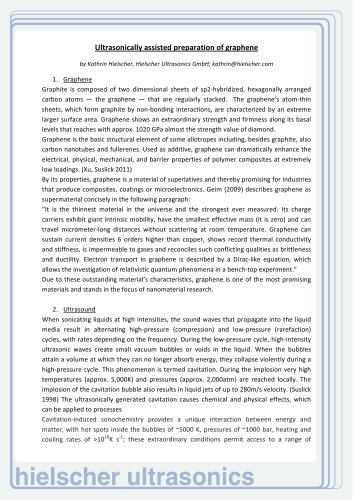
Catalog excerpts
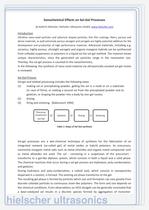
Sonochemical Effects on Sol-Gel Processes by Kathrin Hielscher, Hielscher Ultrasonics GmbH, www.hielscher.com Introduction Ultrafine nano-sized particles and spherical shaped particles, thin film coatings, fibers, porous and dense materials, as well extremely porous aerogels and xerogels are highly potential additives for the development and production of high performance materials. Advanced materials, including e.g. ceramics, highly porous, ultralight aerogels and organic-inorganic hybrids can be synthesized from colloidal suspensions or polymers in a liquid via the sol-gel method. The material shows unique characteristics, since the generated sol particles range in the nanometer size. Thereby, the sol-gel process is counted to the nanochemistry. In the following, the synthesis of nano-sized material via ultrasonically assisted sol-gel routes is reviewed. Sol-Gel Process Sol-gel and related processing includes the following steps: (1) making sol or precipitating powder, gelling the sol in a mold or on a substrate (in case of films), or making a second sol from the precipitated powder and its gelation, or shaping the powder into a body by non-gel routes; (2) drying; (3) firing and sintering. [Rabinovich 1994] Precursor Suspension Sol-Gel Table 1: Steps of Sol-Gel synthesis Sol-gel processes are a wet-chemical technique of synthesis for the fabrication of an integrated network (so-called gel) of metal oxides or hybrid polymers. As precursors, commonly inorganic metal salts such as metal chlorides and organic metal compounds such as metal alkoxides are used. The sol - consisting in a suspension of the precursors transforms to a gel-like diphasic system, which consists in both a liquid and a solid phase. The chemical reactions that occur during a sol-gel process are hydrolysis, poly-condensation, and gelation. During hydrolysis and poly-condensation, a colloid (sol), which consists in nanoparticles dispersed in a solvent, is formed. The existing sol phase transforms to the gel. The resulting gel-phase is formed by particles which size and formation can vary greatly from discrete colloidal particles to continuous chain-like polymers. The form and size depends on the chemical conditions. From observations on SiO2 alcogels can be generally concluded that a base-catalyzed sol results in a discrete species formed by aggregation of monomer-
Open the catalog to page 1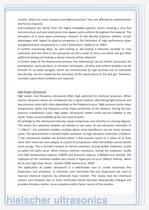
clusters, which are more compact and highly branched. They are affected by sedimentation and forces of gravity. Acid-catalyzed sols derive from the highly entangled polymer chains showing a very fine microstructure and very small pores that appear quite uniform throughout the material. The formation of a more open continuous network of low density polymers exhibits certain advantages with regard to physical properties in the formation of high performance glass and glass/ceramic components in 2 and 3 dimensions. [Sakka et al. 1982] In further processing steps, by spin-coating or dip-coating...
Open the catalog to page 2
Furthermore, chemical reactions can profit from sonochemical effects, which include e.g. the breakage of chemical bonds, significant enhancement of chemical reactivity or molecular degradation. Sono-Gels In sono-catalytically assisted sol-gel reactions, ultrasound is applied to the precursors. The resulting materials with new characteristics are known as sonogels. Due to the absence of additional solvent in combination with the ultrasonic cavitation, a unique environment for sol–gel reactions is created, which allows for the formation of particular features in the resulting gels: high...
Open the catalog to page 3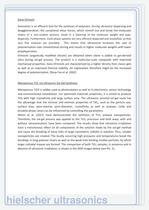
Sono-Ormosil Sonication is an efficient tool for the synthesis of polymers. During ultrasonic dispersing and deagglomeration, the caviational shear forces, which stretch out and break the molecular chains in a non-random process, result in a lowering of the molecular weight and polydispersity. Furthermore, multi-phase systems are very efficient dispersed and emulsified, so that very fine mixtures are provided. This means that ultrasound increases the rate of polymerisation over conventional stirring and results in higher molecular weights with lower polydispersities. Ormosils (organically...
Open the catalog to page 4
Pic. 2: SEM images of Ti02 pwder, calcinated at 400 degC for lh and gelatinization time of 24h: (a) in the presence of and (b) in the absence of ultrasound. [Milani et al. 2011] The images of the surface of the powder samples show clearly that using ultrasonic waves resulted in greater homogeneity in the average size of the particles and resulted in smaller particles. Due to sonication, the average particle size decreases by approx. 3 nm. [Milani et The positive effects of ultrasound are proven in various resear studies. E.g., report Neppolian et al. in their work the importance and...
Open the catalog to page 5
Table 2: Ultrasonic sol-gel synthesis of mesoporous TiO2 [Yu et al., Chem. Commun. 2003, 2078] Nanocoating via ultrasonic sol-gel reaction Nanocoating means covering material with a nano-scaled layer or the coverage of a nanosized entity. Thereby encapsulated or core-shell structures are obtained. Such nano composites feature physical and chemical high performance properties due to combined specific characteristics and/or structuring effects of the components. Exemplarily, the coating procedure of indium tin oxide (ITO) particles will be demonstrated. ITO particles are coated with silica in...
Open the catalog to page 6
Conclusion The application of ultrasound to sol-gel processes leads to a better mixing and the particles’ deagglomeration. This results in smaller particles size, spherical, low-dimensional particle shape and enhanced morphology. So-called sono-gels are characterized by their density and fine, homogeneous structure. These features are created due to the avoidance of use of solvent during the sol formation, but also, and mainly, because of the initial cross-linked state of reticulation induced by ultrasound. After the drying process, the resulting sonogels present a particulate structure,...
Open the catalog to page 7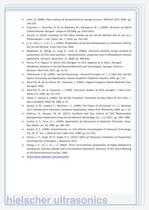
Chen, Q. (2009): Silica coating of nanoparticles by sonogel process. SIMTech 10/4, 2009. pp. 216-220. Esquivias, L.; Rosa-Fox, N. de la; Bejarano, M.; Mosquera, M. J. (2004): Structure of Hybrid Colloid-Polymer Xerogels. Langmuir 20/2004. pp. 3416-3423. Karami, A. (2010): Synthesis of TiO2 Nano Powder by the Sol-Gel Method and Its Use as a Photocatalyst. J. Iran. Chem. Soc. 7, 2010. pp. 154-160. Li, X.; Chen, L.; Li, B.; Li. L. (2005): Preparation of Zirconia Nanopowders in Ultrasonic Field by the Sol-Gel Method. Trans Tech Pub. 2005. Neppolian, B.; Wang, Q.; Jung, H.; Choi, H. (2008):...
Open the catalog to page 8All Hielscher catalogs and technical brochures
-
Ultrasonic Process Lab
1 Pages
-
Ultrasonic Wire Cleaning
4 Pages
-
Ultrasonic Applications
1 Pages
-
Hielscher Ultrasonic Sieves
2 Pages










